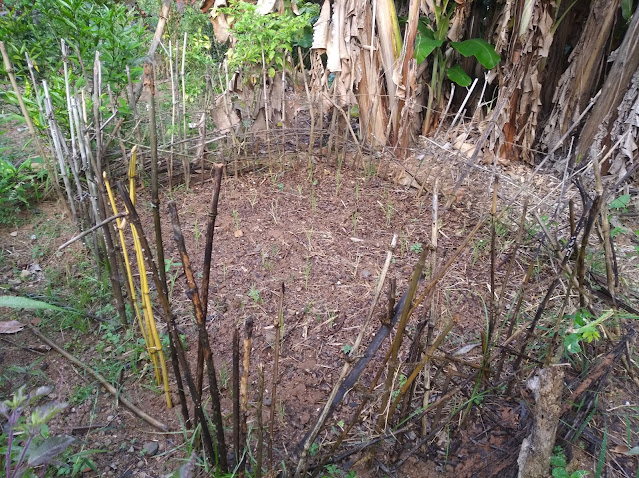In one area, I have planted Super Napier grass, Mexican sunflower and other types of weeds growing. Super Napier gives lots of mulch which decomposes slowly and Mexican sunflower gives lots of mulch which decomposes fast. Cut and mulched both of them and weeds at the base of the coconut tree, would like to see how fast does the super napier grows back and the effect of mulching on the trees. One tree is in bad condition, while another tree is relatively OK.
Friday, October 28, 2022
Happy hill rice - October
Trying happy hill rice again, so that there are more seeds in the next rainy season. Soaked seeds in water for 24 hours and then kept them in wet cloth and after germination kept in seed tray. Seed tray is filled with home made compost and coir brick and seeds were planted. In couple of days, seeds came up and after 12 days, there were transplanted to the area. This area was previously mulched with leaves, ideally thick cover of leaves should be left to decompose atleast for 2 months and then used. If the leaves are not decomposed well, then making lines is difficult, ideally the mulch should be decomposed well to make the seeding easy.
It has been tried in 3 places...
9-November-2022
Watering this everyday
Sunday, October 16, 2022
No-till rice - some rethoughts
My no-till experiment started in the month of June 2022, looks OK so far. There are two areas one was .05 acre and grass was growing in this, but this area is not tilled close to 3 years now. Another area is 0.15 acre and this area was having pureria javanica growing close to an year and all weeds were eliminated nicely.
In 0.05 acre, I cut the grass using Scythe and then using brush cutter so that all the existing weeds are cut and cleared. One problem was that there were millipedes in the mulch some of there were killed while using the brush cutter. But after cutting the grass, the ground was clean, like in conventional rice field, after puddling, it will be completely free of weeds. In this case, the grass will grow back quickly, but in conventional rice fields, they will take lot of time, before that rice will be established. Seeds were put using a row seeder which opens up the ground and pre-soaked seeds for 12 hours were sown. The variety was an upland variety which grows tall, around 4.5 feet and can compete with grass well. Also in the last time, there were good rain and standing water in the field which controlled weeds naturally.
Overall, to conclude, if the weeds are cut nicely and a tall variety is used, chances of success in no-till rice is more. If there is standing water to control weeds, it is much better. In this case, I didn't use cut grass as mulch since I thought, it may interfere with weeding, if at all I have to do that. On a later thought, if decomposed mulch is used for mulch, it would be much better.
In 0.15 acre, since Pureria Javanica was growing and all weeds were removed, after cutting Pureria, the field was completely weed free. Here also seeds of another upland rice variety was used which grows to 4-5 feet. Here also mulch was not used, but got better weed control since rain was good and there were standing water in the field.
11-July-2023 (Current plan for no-till)
After the rice cultivation, sesame was tried out, it didn't come out uniformly, so yield was very very poor. After this field was left uncultivated, since anyway establishing pureria was not an option since there was no moisture at this point. As usual grass started growing and took the complete field. With start of summer rain, sown cowpea but this didn't control the grass completely.
At this point one option looks to be just keep mulching the field after the 2nd crop so that strong grasses won't grow well. Even if there are few grasses at the time of cultivation, that can be easily pulled out. To mulch the field after 2nd crop thinking of growing some fodder grass around the field which decomposes very slowly and hence provides good weed control. June to October will be 1st crop (some times rain starts at July only) and September to December would be 2nd crop after this 5 months (January to May) will be idle period and this time field should be completely mulched where ever there is weeds. To what extend the mulch will be decomposed by the next June has to be seen. Mostly the mulch has to be kept aside and then only seeds can be sown.












